Mexico Diabetes Drugs Market Size
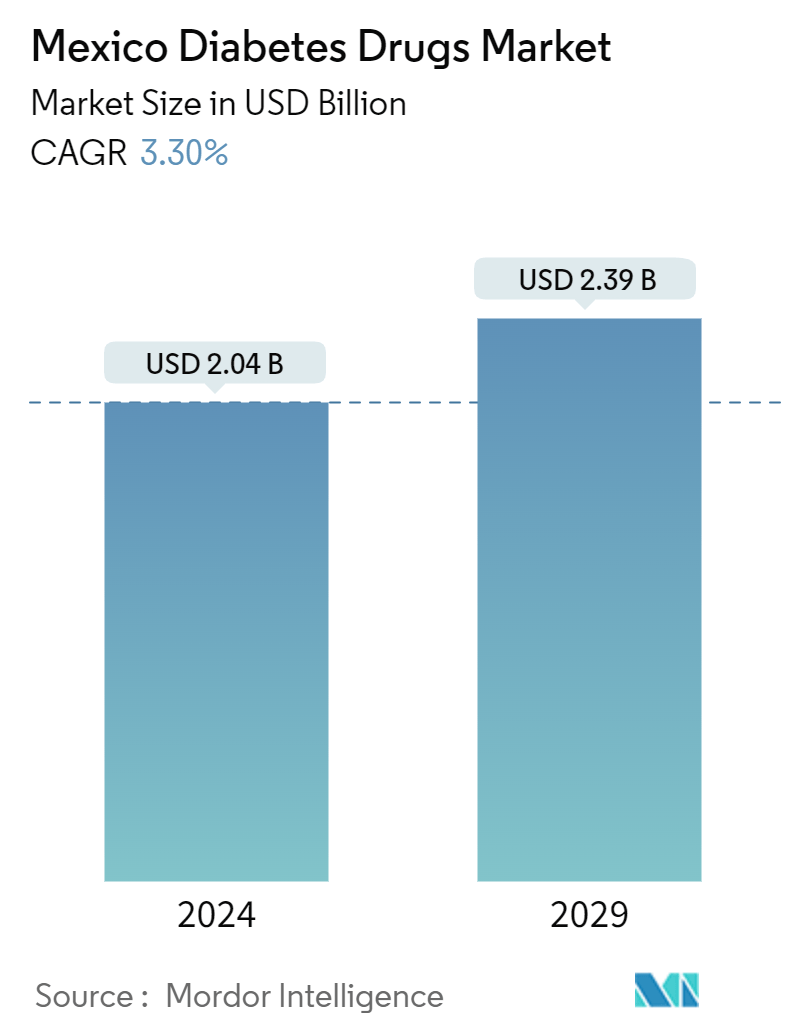
| Study Period | 2018 - 2029 |
| Base Year For Estimation | 2023 |
| Forecast Data Period | 2024 - 2029 |
| Market Size (2024) | USD 2.04 Billion |
| Market Size (2029) | USD 2.39 Billion |
| CAGR (2024 - 2029) | 3.30 % |
Major Players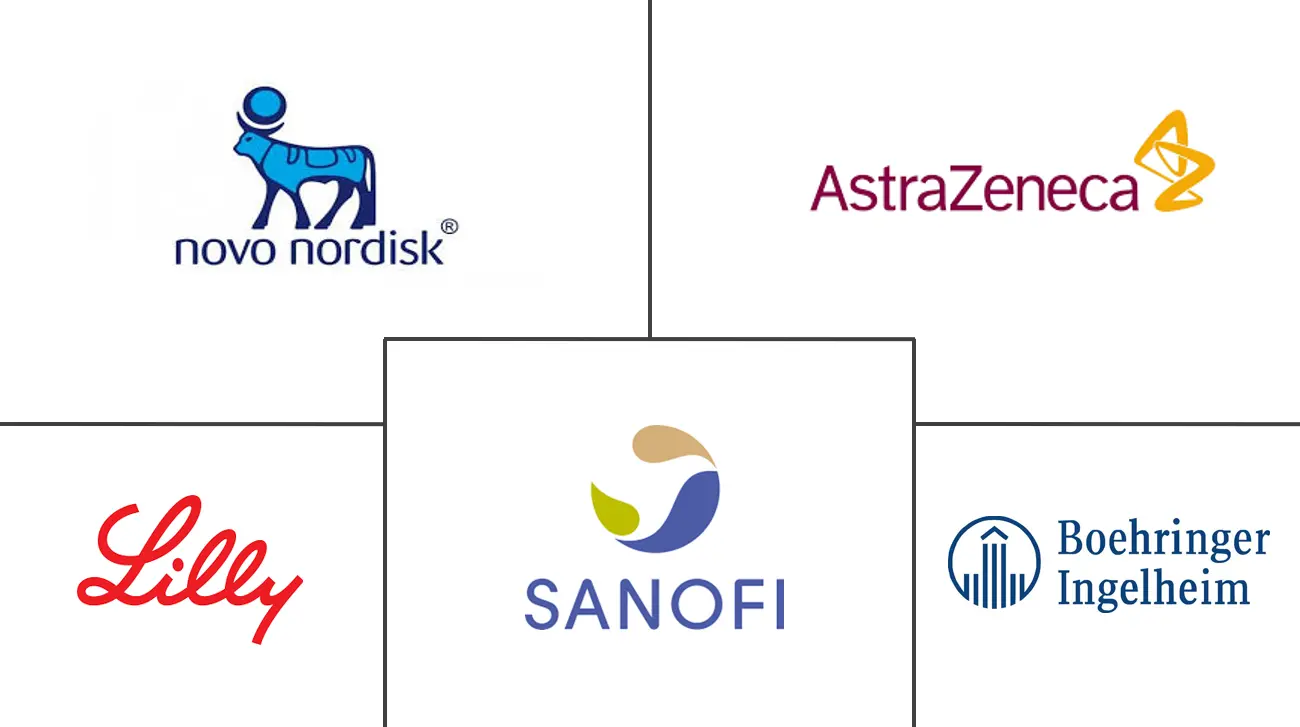
*Disclaimer: Major Players sorted in no particular order |
Mexico Diabetes Drugs Market Analysis
The Mexico Diabetes Drugs Market size is estimated at USD 2.04 billion in 2024, and is expected to reach USD 2.39 billion by 2029, growing at a CAGR of 3.30% during the forecast period (2024-2029).
In Mexico, diabetes, especially Type 2, became a healthcare burden as it is the primary cause of death among women and the secondary cause of death among men. Obesity, sedentarism, bad eating habits, genetics, family background, and age are among the factors that lead to developing diabetes. Therefore, owing to the aforementioned factors the studied market is anticipated to witness growth over the analysis period.
In 2022, the International Diabetes Federation estimated that approximately 14.1 million adults in Mexico were affected by diabetes. This accounts for nearly 17 percent of the entire adult population in the country, which equated to over 83 million individuals during that year. Overweight is identified as one of the risk factors associated with this disease, and it is projected that the proportion of overweight individuals in Mexico will continue to rise in the coming years.
there are 11 million adults in the country have Impaired Glucose tolerance (IGT), which places them at high risk of developing type 2 diabetes. Diabetes-related health expenditure in Mexico has reached USD 20 billion, putting it in the top ten countries or territories with the highest total health expenditure. Under half (47.5%) of people living with diabetes in the country are undiagnosed.
When diabetes is undetected or inadequately treated, people with diabetes are at risk of serious and life-threatening complications, such as heart attack, stroke, kidney failure, blindness, and lower-limb amputation. These result in reduced quality of life and higher healthcare costs and lead to a greater need for access to care.
Mexico Diabetes Drugs Market Trends
The oral anti-diabetic drugs segment holds the highest market share in the Mexico Diabetes Drugs Market in the current year
Mexico witnessed an alarming increase in the prevalence of diabetes in recent years. Patients with diabetes require many corrections throughout the day to maintain nominal blood glucose levels, such as oral anti-diabetic medication or ingestion of additional carbohydrates by monitoring their blood glucose levels. The rate of newly diagnosed Type 1 and Type 2 diabetes cases is seen to increase, mainly due to obesity, unhealthy diet, and physical inactivity. The rapidly increasing incidence and prevalence of diabetic patients and healthcare expenditure are indications of the increasing usage of diabetic drugs.
Oral Anti-Diabetic Drugs are available internationally and are recommended for use when escalation of treatment for type 2 diabetes is required along with lifestyle management. Oral agents are typically the first medications used in treating type 2 diabetes due to their wide range of efficacy, safety, and mechanisms of action. Anti-diabetic drugs help diabetes patients control their condition and lower the risk of diabetes complications.
People with diabetes may need to take anti-diabetic drugs for their whole lives to control their blood glucose levels and avoid hypoglycemia and hyperglycemia. Oral anti-diabetic agents present the advantages of easier management and lower cost. So they became an attractive alternative to insulin with better acceptance, which enhances adherence to the treatment.
Lack of health insurance deprives people experiencing poverty of access to services and puts them at risk of financial hardship. To protect the people against excessive health expenditures, many countries like Mexico implemented community-based health insurance, national health insurance, and targeted public health insurance. Mexico includes multiple health insurance providers. The Instituto de Seguridad y Servicios Sociales de los Trabajadores del Estado [State Employee's Social Security and Social Services Institute, ISSSTE] provides coverage for government employees, and the Instituto Mexico del Seguro Social [Mexico Social Security Institute, IMSS] covers for private-sector employees.
The Seguro Popular [People's Insurance] was launched to protect the working-age population against steep healthcare costs. Enrolment in the Seguro Popular is independent of health status or pre-existing illness. There is no co-payment under the type of health care received, and family contributions are determined solely by the ability to pay. The various initiatives by the Mexican government are expected to drive the market's growth.
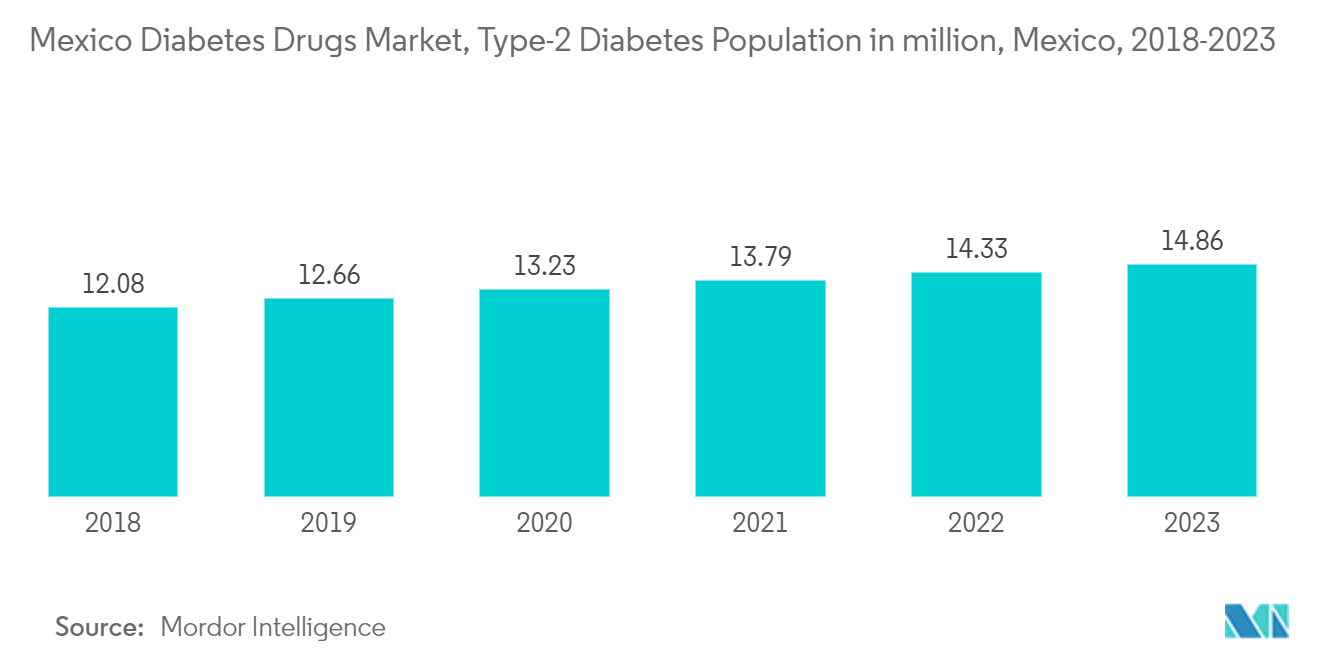
Sodium-glucose cotransport -2 (SGLT-2) inhibitor Segment is Expected to register the highest CAGR in the Mexico Diabetes Drugs Market over the forecast period
SGLT-2 inhibitors, also called gliflozins, are a medicine class used to lower high blood glucose levels in people with type 2 diabetes. SGLT-2 inhibitors act independently of beta-cell function in the pancreas. SGLT-2 drugs significantly manage cardiovascular risk factors, including blood pressure, cardiac function, and antiinflammatory activity. SGLT-2 inhibitors are effective at lowering hemoglobin A1c levels and improving weight loss. They include a low risk of hypoglycemia and are usually well tolerated. Technological advancements increased over the period leading to several modifications in the SGLT-2 inhibitors or the formulations being developed.
Diabetes is a significant health problem and one of the extraordinary challenges for healthcare systems all over Mexico. The disease's growing incidence, prevalence, and progressive nature encouraged the development of new drugs to provide additional treatment options for diabetic patients. The roll-out of many new products, increasing international research collaborations in technology advancement, and increasing awareness about diabetes among people are some of the market opportunities for the players in the diabetes drugs market.
Pharmacies are considered an important tool for achieving better healthcare coverage in Mexico. The pharmaceutical industry includes integrated technology tools. Through the 'Beyond the Pills' initiative, companies complement their drug treatment with digital platforms to favor follow-up and ensure treatment continuity.
Roche is one of the companies using the Beyond the Pills approach for treating diabetes. The pharmaceutical company includes a digital platform to manage diabetes called mu Sugr. Through it, Roche can offer accessible patient solutions within an open platform to respond to unmet needs. It aims to support people with diabetes to spend more time in their ideal glucose target range and improve their quality of life.
Owing to the factors above, the market will likely continue to grow.
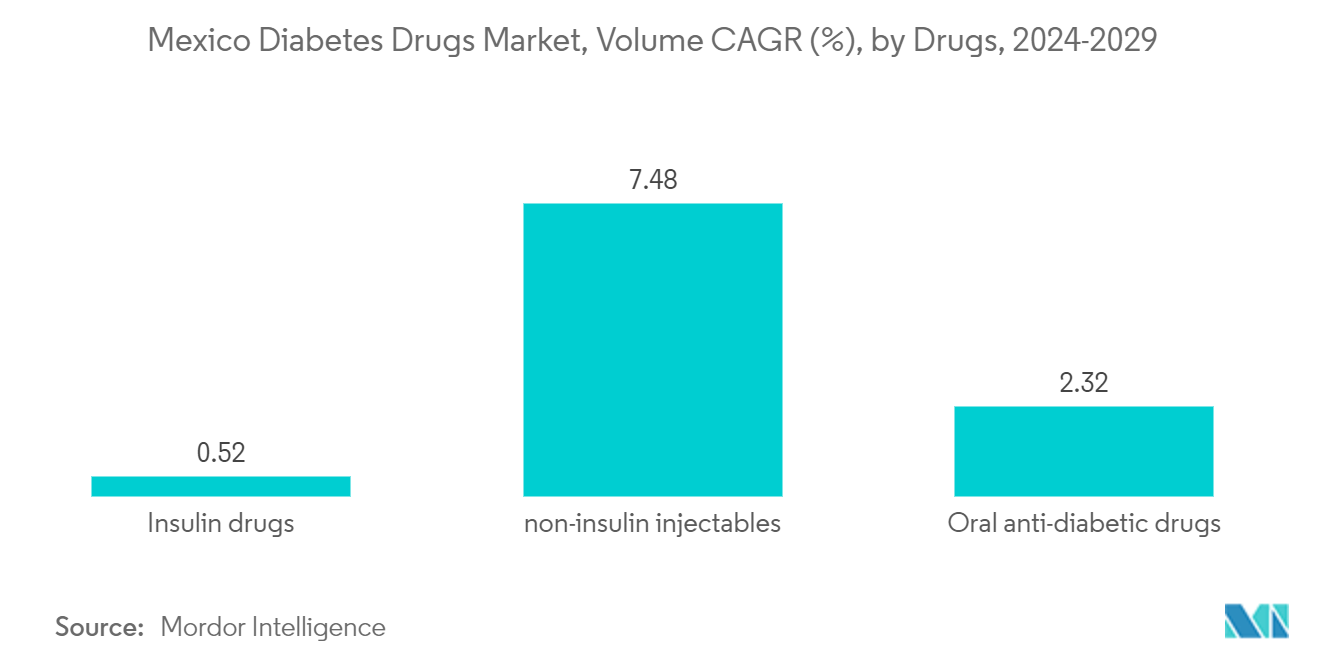
Mexico Diabetes Drugs Industry Overview
The Mexico Diabetes Drugs Market is moderately consolidated, with major manufacturers, namely Eli Lilly, Sanofi, Novo Nordisk, AstraZeneca, and other generic players, holding a presence in the region. A major share of the market is held by manufacturers concomitant with strategy-based M&A operations and constantly entering the market to generate new revenue streams and boost existing ones.
Mexico Diabetes Drugs Market Leaders
-
AstraZeneca
-
Novo Nordisk
-
Boehringer Ingelheim
-
Eli Lilly and Company
-
Sanofi Aventis
*Disclaimer: Major Players sorted in no particular order
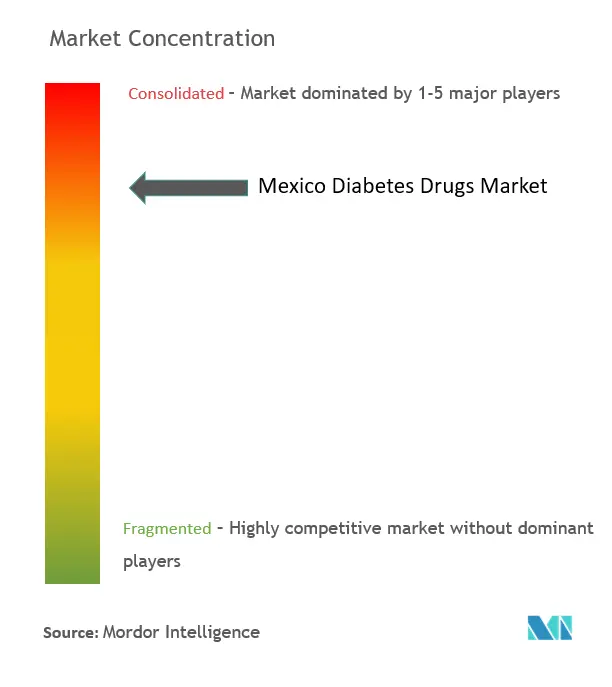
Mexico Diabetes Drugs Market News
- November 2023: Novo Nordisk has recently expanded its site to produce GLP-1 drugs, aiming to sustain its robust growth in the treatment of type 2 diabetes (T2D) following the introduction of Eli Lilly's Zepbound earlier this month.
- March 2022: Oramed announced ORMD-0801 (a new molecule) is being evaluated in two pivotal Phase 3 trials and can be the first oral insulin capsule with the most convenient and safest way to deliver insulin therapy. This drug is expected to be a game-changer in the insulin and oral anti-diabetes drugs markets.
Mexico Diabetes Drugs Market Report - Table of Contents
1. INTRODUCTION
- 1.1 Study Assumptions and Market Definition
- 1.2 Scope of the Study
2. RESEARCH METHODOLOGY
3. EXECUTIVE SUMMARY
4. MARKET DYNAMICS
- 4.1 Market Overview
- 4.2 Market Drivers
- 4.3 Market Restraints
-
4.4 Porter's Five Forces Analysis
- 4.4.1 Bargaining Power of Suppliers
- 4.4.2 Bargaining Power of Consumers
- 4.4.3 Threat of New Entrants
- 4.4.4 Threat of Substitute Products and Services
- 4.4.5 Intensity of Competitive Rivalry
5. MARKET SEGMENTATION
-
5.1 Insulins
- 5.1.1 Basal or Long Acting Insulins
- 5.1.1.1 Lantus (Insulin Glargine)
- 5.1.1.2 Levemir (Insulin Detemir)
- 5.1.1.3 Toujeo (Insulin Glargine)
- 5.1.1.4 Tresiba (Insulin Degludec)
- 5.1.1.5 Basaglar (Insulin Glargine)
- 5.1.2 Bolus or Fast Acting Insulins
- 5.1.2.1 NovoRapid/Novolog (Insulin Aspart)
- 5.1.2.2 Humalog (Insulin Lispro)
- 5.1.2.3 Apidra (Insulin Glulisine)
- 5.1.3 Traditional Human Insulins
- 5.1.3.1 Novolin/Actrapid/Insulatard
- 5.1.3.2 Humulin
- 5.1.3.3 Insuman
- 5.1.4 Biosimilar Insulins
- 5.1.4.1 Insulin Glargine Biosimilars
- 5.1.4.2 Human Insulin Biosimilars
-
5.2 Oral Anti-diabetic drugs
- 5.2.1 Biguanides
- 5.2.1.1 Metformin
- 5.2.2 Alpha-Glucosidase Inhibitors
- 5.2.2.1 Alpha-Glucosidase Inhibitors
- 5.2.3 Dopamine D2 receptor agonist
- 5.2.3.1 Bromocriptin
- 5.2.4 SGLT-2 inhibitors
- 5.2.4.1 Invokana (Canagliflozin)
- 5.2.4.2 Jardiance (Empagliflozin)
- 5.2.4.3 Farxiga/Forxiga (Dapagliflozin)
- 5.2.4.4 Suglat (Ipragliflozin)
- 5.2.5 DPP-4 inhibitors
- 5.2.5.1 Onglyza (Saxagliptin)
- 5.2.5.2 Tradjenta (Linagliptin)
- 5.2.5.3 Vipidia/Nesina(Alogliptin)
- 5.2.5.4 Galvus (Vildagliptin)
- 5.2.6 Sulfonylureas
- 5.2.6.1 Sulfonylureas
- 5.2.7 Meglitinides
- 5.2.7.1 Meglitinides
-
5.3 Non-Insulin Injectable drugs
- 5.3.1 GLP-1 receptor agonists
- 5.3.1.1 Victoza (Liraglutide)
- 5.3.1.2 Byetta (Exenatide)
- 5.3.1.3 Bydureon (Exenatide)
- 5.3.1.4 Trulicity (Dulaglutide)
- 5.3.1.5 Lyxumia (Lixisenatide)
- 5.3.2 Amylin Analogue
- 5.3.2.1 Symlin (Pramlintide)
-
5.4 Combination drugs
- 5.4.1 Insulin combinations
- 5.4.1.1 NovoMix (Biphasic Insulin Aspart)
- 5.4.1.2 Ryzodeg (Insulin Degludec and Insulin Aspart)
- 5.4.1.3 Xultophy (Insulin Degludec and Liraglutide)
- 5.4.2 Oral Combinations
- 5.4.2.1 Janumet (Sitagliptin and Metformin)
6. MARKET INDICATORS
- 6.1 Type-1 Diabetic Population
- 6.2 Type-2 Diabetic Population
7. COMPETITIVE LANDSCAPE
-
7.1 COMPANY PROFILES
- 7.1.1 Novo Nordisk A/S
- 7.1.2 Takeda
- 7.1.3 Pfizer
- 7.1.4 Eli Lilly
- 7.1.5 Janssen Pharmaceuticals
- 7.1.6 Astellas
- 7.1.7 Boehringer Ingelheim
- 7.1.8 Merck and Co.
- 7.1.9 AstraZeneca
- 7.1.10 Bristol Myers Squibb
- 7.1.11 Novartis
- 7.1.12 Sanofi Aventis
- *List Not Exhaustive
-
7.2 COMPANY SHARE ANALYSIS
- 7.2.1 Novo Nordisk A/S
- 7.2.2 Sanofi Aventis
- 7.2.3 Eli Lilly
- 7.2.4 Merck and Co.
- 7.2.5 Others
8. MARKET OPPORTUNITIES AND FUTURE TRENDS
** Subject To AvailablityMexico Diabetes Drugs Industry Segmentation
Diabetes Drugs are used to manage diabetes mellitus by lowering the glucose level in the blood. The Mexico Diabetes Drugs Market is segmented into drugs, oral anti-diabetic drugs, non-insulin injectable drugs and combination drugs. The report offers the value (in USD) and volume (in units) for the above segments.
| Insulins | Basal or Long Acting Insulins | Lantus (Insulin Glargine) |
| Levemir (Insulin Detemir) | ||
| Toujeo (Insulin Glargine) | ||
| Tresiba (Insulin Degludec) | ||
| Basaglar (Insulin Glargine) | ||
| Insulins | Bolus or Fast Acting Insulins | NovoRapid/Novolog (Insulin Aspart) |
| Humalog (Insulin Lispro) | ||
| Apidra (Insulin Glulisine) | ||
| Insulins | Traditional Human Insulins | Novolin/Actrapid/Insulatard |
| Humulin | ||
| Insuman | ||
| Insulins | Biosimilar Insulins | Insulin Glargine Biosimilars |
| Human Insulin Biosimilars | ||
| Oral Anti-diabetic drugs | Biguanides | Metformin |
| Oral Anti-diabetic drugs | Alpha-Glucosidase Inhibitors | Alpha-Glucosidase Inhibitors |
| Oral Anti-diabetic drugs | Dopamine D2 receptor agonist | Bromocriptin |
| Oral Anti-diabetic drugs | SGLT-2 inhibitors | Invokana (Canagliflozin) |
| Jardiance (Empagliflozin) | ||
| Farxiga/Forxiga (Dapagliflozin) | ||
| Suglat (Ipragliflozin) | ||
| Oral Anti-diabetic drugs | DPP-4 inhibitors | Onglyza (Saxagliptin) |
| Tradjenta (Linagliptin) | ||
| Vipidia/Nesina(Alogliptin) | ||
| Galvus (Vildagliptin) | ||
| Oral Anti-diabetic drugs | Sulfonylureas | Sulfonylureas |
| Oral Anti-diabetic drugs | Meglitinides | Meglitinides |
| Non-Insulin Injectable drugs | GLP-1 receptor agonists | Victoza (Liraglutide) |
| Byetta (Exenatide) | ||
| Bydureon (Exenatide) | ||
| Trulicity (Dulaglutide) | ||
| Lyxumia (Lixisenatide) | ||
| Non-Insulin Injectable drugs | Amylin Analogue | Symlin (Pramlintide) |
| Combination drugs | Insulin combinations | NovoMix (Biphasic Insulin Aspart) |
| Ryzodeg (Insulin Degludec and Insulin Aspart) | ||
| Xultophy (Insulin Degludec and Liraglutide) | ||
| Combination drugs | Oral Combinations | Janumet (Sitagliptin and Metformin) |
Mexico Diabetes Drugs Market Research FAQs
How big is the Mexico Diabetes Drugs Market?
The Mexico Diabetes Drugs Market size is expected to reach USD 2.04 billion in 2024 and grow at a CAGR of 3.30% to reach USD 2.39 billion by 2029.
What is the current Mexico Diabetes Drugs Market size?
In 2024, the Mexico Diabetes Drugs Market size is expected to reach USD 2.04 billion.
Who are the key players in Mexico Diabetes Drugs Market?
AstraZeneca, Novo Nordisk, Boehringer Ingelheim, Eli Lilly and Company and Sanofi Aventis are the major companies operating in the Mexico Diabetes Drugs Market.
What years does this Mexico Diabetes Drugs Market cover, and what was the market size in 2023?
In 2023, the Mexico Diabetes Drugs Market size was estimated at USD 1.97 billion. The report covers the Mexico Diabetes Drugs Market historical market size for years: 2018, 2019, 2020, 2021, 2022 and 2023. The report also forecasts the Mexico Diabetes Drugs Market size for years: 2024, 2025, 2026, 2027, 2028 and 2029.
Mexico Diabetes Drugs Industry Report
Statistics for the 2024 Mexico Diabetes Drugs market share, size and revenue growth rate, created by Mordor Intelligence™ Industry Reports. Mexico Diabetes Drugs analysis includes a market forecast outlook to 2029 and historical overview. Get a sample of this industry analysis as a free report PDF download.



